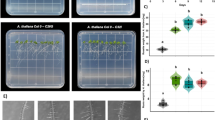Abstract
Ascophyllum nodosum extract products are used commercially in the form of liquid concentrate and soluble powder. These formulations are manufactured from seaweeds that are harvested from natural habitats with inherent environmental variability. The seaweeds by themselves are at different stages of their development life-cycle. Owing to these differences, there could be variability in chemical composition that could in turn affect product consistency and performance. Here, we have tested the applicability of using Arabidopsis thaliana as a model to study the activity of two different extracts from A. nodosum. Three different bioassays: Arabidopsis root-tip elongation bioassay, Arabidopsis liquid growth bioassay and greenhouse growth bioassay were evaluated as growth assays. Our results indicate that both extracts promoted root and shoot growth in comparison to controls. Further, using Arabidopsis plants with a DR5:GUS reporter gene construct, we provide evidence that components of the commercial A. nodosum extracts modulates the concentration and localisation of auxins which could account, at least in part, for the enhanced plant growth. The results suggest that A. thaliana could be used effectively as a rapid means to test the bioactivity of seaweed extracts and fractions.



Similar content being viewed by others
References
Blunden G (1991) Agricultural uses of seaweeds and seaweed products. In: Guiry MD, Blunden G (eds) Seaweed resources in Europe: uses and potential. Wiley, Chichester, pp 65–81
Blunden G, Jenkins T, Liu YW (1997) Enhanced leaf chlorophyll levels in plants treated with seaweed extract. J Appl Phycol 8:535–543
Featonby-Smith BC, van Staden J (1983) The effect of seaweed concentrate on the growth of tomatoes in nematode infested soil. Scient Hortic 20:137–146
Halfter U, Ishitani M, Zhu JK (2000) The Arabidopsis SOS2 protein kinase physically interacts with and is activated by the calcium-binding protein SOS3. Proc Natl Acad Sci USA 97:3735–3750
Haug A, Larsen B (1958) Chemical composition of the brown alga Ascophyllum nodosum (L.) Le Jol.: Influence of habitat on the chemical composition of Ascophyllum nodosum. Nature 181:1224–1225
Jefferson RA (1987) Assay for chimeric genes in plants: the GUS fusion system. Plant Mol Biol Rep 5:387–405
Kramer EM, Bennett MJ (2006) Auxin transport: a field in flux. Trends Plant Sci 11:382–386
Meinke DW, Cherry JM, Dean C, Rounsley SD, Koornneef M (1998) Arabidopsis thaliana: A model plant for genome analysis. Science 282:662–682
Metting B, Zimmerman WJ, Crouch T, Van-Staden J (1990) Agronomic uses of seaweed and microalgae. In: Akatsuka I (eds) Introduction of applied phycology. SPB, The Hague, pp 589–627
Moller M, Smith ML (1999) The effects of priming treatments using seaweed suspensions on the water sensitivity of barley (Hordeum vulgare L.) caryopses. Ann Appl Biol 135:515–521
Murashige T, Skoog F (1962) A revised medium for rapid growth and bioassays with tobacco cultures. Physiol Planta 15:473–479
Nabati DA (1991) Response of two grass species to plant growth regulators, fertilizer N, chelated Fe, salinity and water stress. PhD dissertation. Virginia Polytechnic Institute and State University, Blacksburg
Nabati DA, Schmidt RE, Parrish DJ (1994) Alleviation of salinity stress in kentucky bluegrass by plant growth regulators and iron. Crop Sci 34:198–202
Patier P, Yvin JC, Kloareg B, Lienart Y, Rochas C (1993) Seaweed liquid fertilizer from Ascophyllum nodosum contains elicitors of plant d-glycanases. J Appl Phycol 5:343–349
Saravanan S, Thamburaj S, Veeraragavathatham D, Subbiah A (2003) Effect of seaweed extract and chlormequat on growth and fruit yield of tomato (Lycopersicon esculentum Mill.). Indian J Agric Res 37:79–87
Shanab SMM (2007) Antioxidant and antibiotic activities of some seaweeds (Egyptian isolates). Int J Agric Biol 9:220–225
Sharp RE, Davies WJ (1989) Regulation of growth and development of plants growing with a restricted supply of water. In: Jones HG, Flowers TL, Jones MB (eds) Plants under stress. Cambridge University Press, Cambridge, pp 71–93
Tang HF, Yi YH, Yao XS, Xu QZ, Zhang SY, Lin HW (2002) Bioactive steroids from the brown alga Sargassum carpophyllum. J Asian Nat Prod Res 4:95–101
Temple WD, Bomke AA (1989) Effects of kelp (Macrocystis integrifolia and Eklonia maxima) foliar applications on bean crop growth. Plant Soil 117:85–92
Ugarte RA, Sharp G, Moore B (2006) Changes in the brown seaweed Ascophyllum nodosum (L.) Le Jol. Plant morphology and biomass produced by cutter rake harvests in southern New Brunswick, Canada. J Appl Phycol 18:351–359
Ulmasov T, Murfett J, Hagen G, Guilfoyle TJ (1997) Aux/lAA proteins repress expression of reporter genes containing natural and highly active synthetic auxin response elements. Plant Cell 9:1963–1971
Weijers D, Jürgens G (2004) Funneling auxin action: specificity in signal transduction. Curr Opin Plant Biol 7:687–693
Wu Y, Jenkins T, Blunden G, Mende NV, Hankins SD (1998) Suppression of fecundity of the rootknot nematode, Meloidogyne javanica, in monoxenic cultures of Arabidopsis thaliana treated with an alkaline extract of Ascophyllum nodosum. J Appl Phycol 10:91–94
Acknowledgements
The research was supported by the Atlantic Canada Opportunities Agency and Acadian Seaplants Limited.
Author information
Authors and Affiliations
Corresponding author
Rights and permissions
About this article
Cite this article
Rayorath, P., Jithesh, M.N., Farid, A. et al. Rapid bioassays to evaluate the plant growth promoting activity of Ascophyllum nodosum (L.) Le Jol. using a model plant, Arabidopsis thaliana (L.) Heynh. J Appl Phycol 20, 423–429 (2008). https://doi.org/10.1007/s10811-007-9280-6
Received:
Revised:
Accepted:
Published:
Issue Date:
DOI: https://doi.org/10.1007/s10811-007-9280-6




